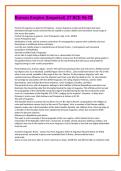Roman Empire (Imperial) 27 BCE-96 CE
Portrait of Augustus as general, Primaporta - answer-Augustus creates portrait types that were
distributed through roman world to then be copied to create a distinct and consistent visual image of
him across the empire
Portrait of Augustus as general , from Primaporta, Italy 1c CE, 20 BCE
Curios Primaporta type
idealization of ruler and his prowess, portraiture for propaganda to express their authority and root
themselves in traditional stories and styles
over-life size marble statue in standard pose of Roman Orator-- Contrapposto and cannonical
proportions of Polykletios
eternally youthful look of Augustus
on his side is Cupid riding a dolphin to claim he is a descendant of Venus
Curiass is covered in scenes representing his military victory over the Parthians and then giving spoils to
the goddess Roma, then we see celestial deities at the top showing that the peace and prosperity
augustus brings is over cosmic proportions
Portrait Bust Livia, Arsinoe, Egypt - answer-This well-executed head does not seek to be a lifelike portrait
but depicts Livia as an idealized, youthful figure. Born in 58 B.C., Livia would have been in her 70s or 80s
when it was carved, probably in the reign of her son, Tiberius. As the emperor Augustus' wife, she
exerted enormous influence over the imperial court and, even after his death in A.D. 14, she retained
her prestige by association with the deified Augustus, the ruling emperor Tiberius, and her other
descendants, who included the future emperors, Gaius (Caligula), Claudius, and Nero.
This portrait of Livia, wife of Augustus, belongs to the tradition of Roman Republican portraiture and
illustrates the classicizing style that triumphed during the reign of Augustus. This official portrait served
the propaganda of the essentially monarchist regime installed during the late first century BC under
cover of a restoration of the Republic (59-27 BC). Judging by the material - basanite - it dates from
Octavian's victory over Mark Anthony and Cleopatra at Actium in 31 BC.
The wife of Augustus
This basanite head is a portrait of Livia (born circa 57 BC, died in AD 29), comparable to her effigies on
coins and hardstone cameos (such as the one in The Hague). Livia, a member of the Roman nobility,
played a major role in the foundation of the Julio-Claudian dynasty. Her children from a first marriage to
a member of the Claudian family were adopted by Octavian Augustus, whom she married in 38 BC
before he became emperor.
Reference to Republican portraiture
This work is a fine example of the propaganda of the new regime, which claimed to be a mere
restoration of the Republic rather than a monarchy. In reality, almost all power (political, military, and
religious) was now in the hands of one man: Augustus. Livia's hairstyle is one that was highly fashionable
from the mid
Ara Pacis Augustae, Rome - answer-Ara Pacis Augustae (Altar of Augustan Peace)m Rome 13-9 BCE
well preserved, excavated in pieces and resembled back in Rome, almost entirely intact
small scale
doors on east and west, altar at centre raised up on steps, 34x38 feet and 28 feet high so relatively small
, historical relief on outside of altar— depiction procession of members of the imperial family, priests and
senators moving towards front/western side of this altar as if they were there for creation of this altar
lower register decorated with plant life— acanthus and fruit, animals, birds, mice, pomegranates,
referencing the plenty and abundance Augustus has brought to the world
enclosure wall around central altar, reached through the stairs
13 BCE to honor Augustus
via flaminana on this road
part of larger complex in the campus marcius— an area of statues to build commeratoive monuments
built close to giant mausoleum of Augustus and next to Giant Sundial- Obelisk or Horologium
Augustus brings obelisks to rome because of his victory against Cleopatra— more obelisk in Rome than
in Egypt
Part of larger architectural program
augustus known for turning a city of brick into a city of marble
Augustus uses marble quarry found by Caesar
Tellus Panel, Ara Pacis Augustae, Rome - answer-Female Personification (tellus), Panel from the East
facade of the Ara Pacis Augustae
symbolising fertility, personifications of land and sea
Augustus had two heirs when this was done and this depicts two baby boys maybe symbolising them
Procession of Imperial Family, Ara Pacis Augustae, Rome - answer-Procession of the Imperial Family,
detail of the south fries of the ara paris augustae
figures here identifiable by their portrait types, compared to parthenon frieze because figures lined up,
but depth of relief varies to show depth and layer people on top of each other
children depiction becomes more important because want to depict their heirs
tax breaks for more children, procreating and increasing number of elite romans through children was
important to Augustus
Forum of Augustus and the Temple of Mars Ultor, Rome - answer-Forum of Augustus- 25-2 BCE
Roman Forum — place voters would elect magistrates, preserved like a museum
and then instead develop imperial forums
Augustus copying things julius caesar has done
creates another forum- forum of augustus
basically large open are with collandes and a temple at the end— Temple of Mars Ultor, mars the
avenger
built up when he set up to avenge julius
most important area of the city of rome get moved into this space— critical area
house the standards, monument to augustan victory on many different levels
Subura- mixed income neighbourhood, known for racaous, narrow winding streets, lots of people in
close quarters, lots of fires
Augustus sets up this forum on the edge of this neighbourhood and then has to protect it from this
neighbourhood
so he puts up a firewall
to protect from fires of subura and to muffle to loud sound coming from it
Temple to mars- italic style temple
becomes model for temples in the imperial period
augustus canonizes this form
uses the Corinthian order— often called the roman corinthian order of the Augustan corinthian order




